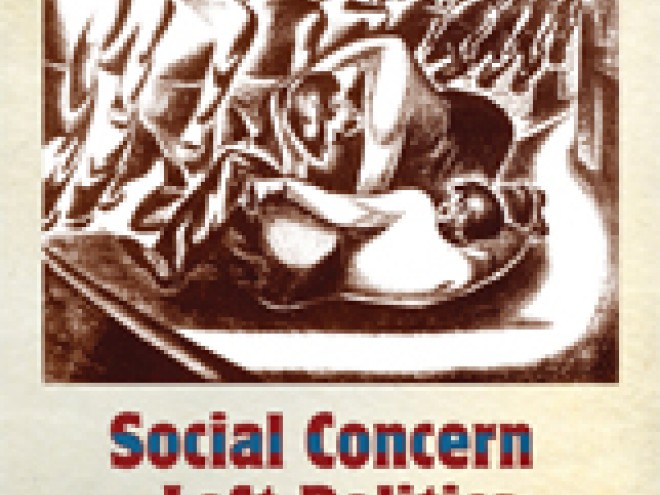Earlier this week, Matthew Baigell wrote about social concern and left politics in Jewish American art. He is the author of a recently published book on the topic and will be blogging here all week for Jewish Book Council’s Visiting Scribe series.
 American Jews or Jewish Americans have had great success in this country. So it is extremely difficult to believe that in the late nineteenth- and early twentieth-centuries, they were the subjects of hundreds of truly vicious cartoons in American humor magazines. These were the decades of the Great Migration from Eastern Europe that began around 1800. Historians have suggested that of all immigrant groups, Jews were the most intensely caricatured and vilified and the cartoons bear out this judgement. Some images are as anti-Semitic as those in old Nazi as well as in contemporary Arab publications.
American Jews or Jewish Americans have had great success in this country. So it is extremely difficult to believe that in the late nineteenth- and early twentieth-centuries, they were the subjects of hundreds of truly vicious cartoons in American humor magazines. These were the decades of the Great Migration from Eastern Europe that began around 1800. Historians have suggested that of all immigrant groups, Jews were the most intensely caricatured and vilified and the cartoons bear out this judgement. Some images are as anti-Semitic as those in old Nazi as well as in contemporary Arab publications.
The cartoonists, rather than portraying immigrants in a welcoming manner or at least show them integrating into American society instead invariably showed them as Shylocks, Fagins, social climbers, criminals, scheming parvenus who would take advantage of any situation in which they found themselves. Tailors gulled clients by selling damaged and ill-fitting clothing, Parents taught children that making money by whatever means was the primary goal in life. Adults sought bargains wherever these could be found. Arson was encouraged in order to collect insurance. The list goes on. Captions, written in broken English as a way to distance the immigrants from native speakers, imitated the speech patterns of those who had not yet mastered the English language.
Judged not as individuals but as an undifferentiated group, Jewish people were considered as the quintessential Other in American culture, the community that might be impossible to fully assimilate, its Zionist impulses and loyalties to a mysterious community of international Jewry being not fully compatible with patriotism or 100 percent Americanism. On the other hand, there was also great jealousy, fear, and hatred all at once because of how quickly Jews had accumulated wealth, had advanced socially, and had developed a professional class of lawyers and doctors.
Instead of positive recognition for their accomplishments, Jews were depicted instead as having huge noses, big bellies, and bowed legs engaged in non-stop heinous activities. Protests over such demeaning caricatures were ineffectual as well as few and far between. Still not certain of their place in America and exhibiting an eastern European reticence to stand up to public abuse, authors apologized and made excuses for Jewish social and commercial misbehaviors, and hoped that in the near future, after learning American ways, they might be accepted somewhat more graciously by the public. The attitude was more hat-in-hand than one of pride in a religion that had given so much to the world.
Even the great novelist Henry James, whose book The American Scene (1906) was a record of his visit to America after living for years abroad, found Jews to be a virtually unstoppable force. In response, on a visit to the Lower East Side of New York, he likened Jews on their fire escapes and in open city squares to squirrels, monkeys, and ants constantly on the move. In establishing a distance between himself and the new Americans, Jews were not only the Other, they were not even considered fully human.
A few cartoons can suggest the attitudes of the cartoonists. “The ‘New Trans-Atlantic Hebrew Line’ ” published in the January 19, 1881 issue of the magazine, Puck, is a comment on the great number of Jewish immigrants from eastern Europe. Even illiterates who could not read the sarcastic caption, “For the Exclusive Use of ‘The Persecuted’,” would know who the persecuted were — the people on the ship, the sailors, the ship itself, the fish in the water, and the bird in the sky by their very hooked noses.

And in a cartoon for the May 11, 1881, of Puck, the cartoonist captured a Coney Island-like scene including hotels, boardwalk promenaders, a sandy beach, bathers, those lying in the sun, and banners on the hotel. The hotel is clearly overloaded with big-nosed Jewish guests. All of those on the boardwalk also have huge noses and some have pot bellies. The women are ostentatiously overdressed for a promenade, a hostile observation that regularly appeared in news stories about Jews at resorts. Those in the water and on the beach are Christians fleeing from the Jews. A couple in the foreground, thumbing their noses, wag their fingers at the departing Christians. The banners on the Hotel de Jerusalem contain two advertisements that in the mind of the cartoonist were placed there by vacationers: “Buy your clothing of Cohen,” and “On his return from Florida, this floor will be occupied by the ISAACS HATTER.” Other banners state: “Look out for the JEW,” “Hebrews not WANTED,” and “No Jews TAKEN.”

Happily, such cartoons largely disappeared by 1930. What had been red meat for cartoonists back then, is no longer acceptable today. That is progress of a sort.
Matthew Baigell is Professor Emeritus in the Department of Art History at Rutgers University. He is the author of numerous books, including American Artists, Jewish Images, and Jewish Art in America: An Introduction. His most recent book is Social Concern and Left Politics in Jewish America Art, 1880 – 1940.
Related Content:
Matthew Baigell is professor emeritus in the department of art history at Rutgers University. He is the author, editor, and coeditor of over twenty books on American and Jewish American art. His most recent book is The Implacable Urge to Defame: Cartoon Jews in the American Press, 1877 – 1935.


